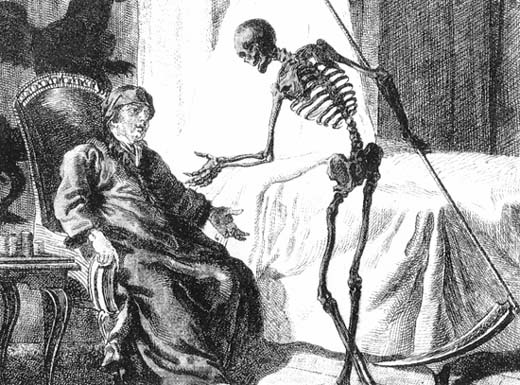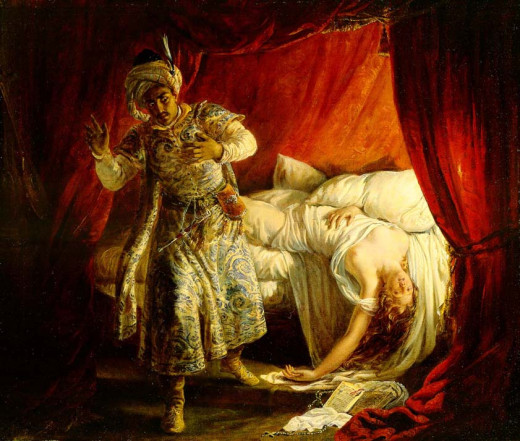10 Types of Delusions
A delusion is a belief held by an individual that contradicts what a culture generally accepts as reality. It can be a single anomaly in an otherwise mentally sound and functional individual, but delusions are also common in schizophrenic patients alongside a myriad of other symptoms. A delusion is different from a hallucination because it deals with a belief or idea in the mind rather than a perception of something that isn't there. For example hearing voices is a hallucination while believing that you can shapeshift into an animal is a delusion.
1. Cotard's Syndrome

Persons with Cotard's syndrome believe that they are dead. This rare delusion, also known as Walking Corpse Syndrome, was recently mentioned on NBC's Hannibal series, but it was first identified in the 19th century by a French neurologist named Jules Cotard. One of Cotard's patients who had this condition, referred to as Mademoiselle X in his lectures, did not feel that she needed to eat because of the syndrome and died of starvation as a result.
A person with Cotard's syndrome may also believe that they are rotting, that they don't exist, or that they are immortal. One reason that these people may believe that they have passed on is that the disease is also connected with an inability to recognize faces and react emotionally to faces so that through their blurry vision others may take on a ghostly quality. I'm surprised no one has referred to it as Dante's syndrome after Dante's Inferno.
2. Clinical Lycanthropy

Lycanthropy is a word for the mythological condition in which a person is able to turn into a wolf, making them a werewolf, while clinical lycanthropy is when a person believes that they can shapeshift into an animal. A person with clinical lycanthropy may actually mimic an animal's movements or sounds. The delusion may be caused by changes in the parts of the brain that represent body shape which means the person may actually have the sense that they are shapeshifting. It's interesting that werewolves once accepted as reality by superstitious people and are now considered a delusion.
3. Fregoli Delusion
People with Fregoli delusion believe that different people they know are the same person who is changing shape. (Kind of like what happens when someone uses Polyjuice potion in the Harry Potter series.) It is believed this is caused by brain dysfuction that impairs the ability to recognize faces. Instead of a neurologist or psychiatrist, this delusion is named after an actor, Leopoldo Fregoli, who made frequent, hasty costume changes.
4. Exbom's Syndrome
People with Ekbom's syndrome or delusional parasitosis believe that they are infested with parasites. These parasites may be worms, lice, fleas, spiders, or other insects. If they specifically feel like the insects are crawling on or beneath their skin this is also known as formication, which is associated with drug withdrawal. This delusion is named after a Swedish neurologist who studied it and published in his findings in 1937 and 1938. Another related condition is delusory cleptoparasitosis, where a person believes that the place they live in is infested and may see insects crawling out of holes in the wall.
5. Capgras Syndrome
With capgras syndrome, a person believes that someone they know has been replaced by someone who looks just like them. Like Cotard's syndrome, Capgras syndrome involves a problem with the perception of faces. Capgras syndrome was first described over forty years after Cotard's syndrome, by a French psychiatrist named Joseph Capgras. He treated a women named Mademoiselle M. who believed that her husband had been replaced by an identical impostor.
6. Othello Syndrome

Othello syndrome is when a person believes that their partner is cheating on them when this is not the case and experiences intense jealousy. The term comes from Shakespeare's play Othello, in which Othello murders his wife Desdemona due to the false belief that she has been unfaithful. Shakespeare's works have remained classics because of his keen understanding of the human psyche. Psychological problems like this one are major elements of many of his plots. In real life, Othello syndrome sometimes really results in the person with the delusion killing themselves or killing their partner.
7. Anton's Syndrome
With Anton's syndrome, blind people deny that they are blind. A person may develop Anton's syndrome if their blindness occurs because the main part of the brain that controls vision dies due to a lack of blood supply caused by an obstruction. However the part of the brain that identifies spatial orientation, color, size, and shape and recognizes objects remains intact. One theory about Anton's syndrome is that the patients are experiencing synesthesia and turning sensory input from their other four senses into visuals that are actually mental images. They believe they are actually seeing these mental images.

8. Clérambault's Syndrome
Clérambault's syndrome or erotomania is when a person believes that another person is in love with them which sometimes results in stalking and trespassing. The targets of erotomania are usually strangers, especially celebrities or people of higher social status. Erotomania is different from unrequited love because the erotomaniac actually believes that the other person is in love with them. They may feel like the other person is sending them messages telepathically.

9. Persecutory Delusions
Persecutory delusions are some of the most well-known types of delusions. Some schizophrenics have paranoia and believe they are being followed and/or spied on. Macbeth from Shakespeare's play becomes paranoid after he takes the throne of Scotland by murdering King Duncan and worries that someone will try to usurp his power the same way that he usurped Duncan's power. A tool used in psychiatry to measure paranoia is the Paranoia Hierarchy, with more normal feelings like fear of rejection and danger at the bottom and the belief that people are intentionally trying to physically and psychologically harm you at the top.
10. Religious Delusions
People with religious delusions believe they are a saint or a god or are in contact with spirits. Religious delusions are common in schizophrenics. Since religious belief is not based on rationality, it can be hard to see at what point a religious person should be considered delusional. Freud thought of religion as an obsessive neurosis and that all religious people didn't see reality clearly. A recent study tried to retrospectively analyze religious figures like Jesus and Moses to determine if they could have been suffering from delusions themselves.








